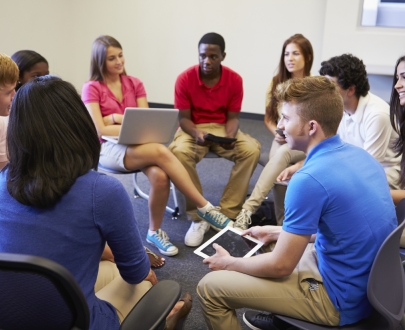
Circle Sharing can encourage students to feel secure and calm. It encourages healthy relationships amongst youth in their classrooms and schools that promotes “integration”. According to author and psychiatrist Dan Seigel[1] when we integrate within relationships, we honour differences between ourselves and others, This promotes linkages through compassionate understanding and communication. Integration creates harmony.
Here are some suggestions to use Circle Sharing with youth. It’s a good idea to use a check-in and debrief circle as bookends to other activities because together they provide a rich opportunity to stimulate the thinking and reflection needed for “integration”.
Daily Circle Check-in
Begin everyday with a circle where students take turns responding to a question and sharing a gauge on their feelings and mood. Consider beginning your circle by asking students to describe their mood on a scale from 1 to 10. 1 is a low mood, 10 is a very positive mood.
Here are some questions you could use in circle check-ins:
-
Personal well-being: What kind of day have you had so far today?
-
Academic success: What’s one thing about school that you’re proud of that you’d like to share with the group?
-
Individual challenges: What task or concern would you like to set aside so that you can be fully present with the class today?
Debriefing Circles
A circle can also be a powerful strategy to debrief a lesson or experience with students. Teachers can facilitate a circle question at the end of an event to encourage students to reflect back on their experiences. You could use quotes to stimulate discussion. Research shows that this type of technique[3] helps to deepen student engagement as it offers relevance, a sense of control, interaction and dialogue.
Successfully used by a program that engages at-risk youth[2], here are some examples of circle debrief questions:
“Look deep into nature then you will understand everything better.” Albert Einstein
- What is something that you understand better about yourself from spending time in nature?
"Our deepest fear is not that we are inadequate, our deepest fear is that we are powerful beyond measure." Marianne Williamson
- What is your own, inherent power and how do you share that with the world?
“The ideal attitude is to be physically loose and mentally tight.” Arthur Ashe
- How are you prepared emotionally, physically and psychologically for this activity?
In his bestselling book Brainstorm: The Power and Purpose of the Teenage Brain, Dr. Dan Siegel applies new research from the field of interpersonal neurobiology to help parents better understand how the teen brain functions.
"Cultivating integration within relationships and the nervous system means we can create the flexible, adaptive, coherent, and stable states of a resilient emerging mind."
The Take a Hike Foundation operates programs that engage at-risk youth using a combination of adventure-based learning, academics, therapy and community involvement.
Researchers asked students what their ideal school would look like and what type of learning environment increases engagement. Among the responses, students listed three criteria describing their preferred types of interaction to promote learning:
- Learn from and with each other and people in their community.
- Connect with experts and expertise.
- Have more opportunities for dialogue and conversation.